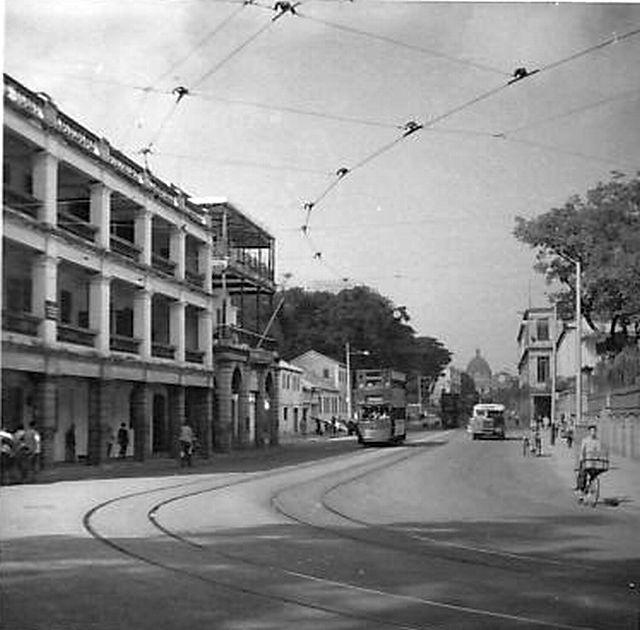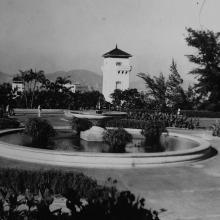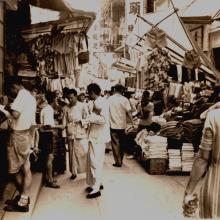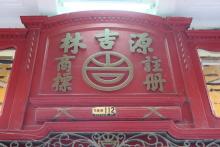The buildings served as the Union Jack Club.
1950s Queensway
Primary tabs

Submitted by moddsey
Date picture taken (may be approximate):
Saturday, January 1, 1955
Gallery:
Connections:
- 1950s Queensway shows Place E Block, Victoria Barracks [????-????]
- 1950s Queensway shows Place G Block, Victoria Barracks (aka Soldiers' Club / NAAFI Club / Union Jack Club) [????-????]




Comments
The photo shows a very sharp
The photo shows a very sharp corner which, until smoothed out to its present state, was a highly dangerous corner on which numerous vehicles came to grief, usually caused by speeding, drunkenness or both. The building on the left is probably the old Union Jack Club (UJC) (one of several clubs for servicemen in Hong Kong in the early fifties)
On the right of the photo, by the chap on the bicycle, can be seen the railings fronting the then HMS Tamar, the front gate to which is a little further down the road out of the picture. Opposite the gate was Rodney Block in the centre of which was the clock tower with the famous "golden clock" face. In fact only the numbers and hands were picked out in gold. But this gave the place its Chinese name of "Kam Chung" usually translated as the "Place of the Golden Clock." This is now the Chinese name for Admiralty MTR Station.
Very best regards,
Gavin C. H. Cooper
The original "Gum Jung" Gold clock ?
Where might we find a photo of the original "Gum Jung" ? I have added this tidbit to the MTR Admiralty Wikipedia entry.
Wellington Barracks
Wellington Barracks as shown here will show the golden clock.
Wouldn't it be fun to run a
Wouldn't it be fun to run a contest to see who personally remembers and has an original photo of the Gum Jung.
Partner with a charity and collect stories at a table at the MTR station.
I'll provide the HK$100 prize for best photo.
Golden Clock Barracks
I have quite by chance stumbled on a newspaper story (not sure which newspaper - it's a clipping and unlabelled) dated 4th May 1962. It is a story about the impending handover of Wellington Barracks to the government following the RN moving out to the new HMS Tamar, built over the filled in dry dock.
It notes that the name 'Gam Chung Ping Fong" (金鐘兵房 Golden Clock Barracks) was given by the local HK personnel of the Royal Engineers (the original members of what became the HK Military Service Corps) to Wellington Barracks soon after the clock was installed in 1890. It was manufactured by Messrs Gillett & Co, Croydon (in 1962 Gillett & Johnston (Clocks) Ltd., Wembley) and provided by the War Department. The story goes on to mention that when the government took over the barracks, the clock was taken by the Royal Engineers and installed in their new barracks "at Castle Peak" - presumably Tai Lam Military Barracks, later Perowne Barracks.
Has anyone any idea what happened next? Was the clock still there in 1994 when the barracks were vacated and the buildings used by Lingnan U as dormitories? Or did the Gurkha Engineers take it with them? It they did, does it still exist?Best,
Stephen D
Showing the "sharp corner"
http://gwulo.com/node/33019#17/22.27782/114.16854/Map_by_ESRI-1909_HK-Ma...
Different corner
Hi Annelise,
The corner you've chosen doesn't have any buildings on the left side of the road, so it doesn't match the photo.
The corner shown in the photo is a bit further west, just to the right of the marker at:
http://gwulo.com/node/16094#18/22.27772/114.16479/Map_by_ESRI-1909_HK-Ma...
Regards,
David
What happened next to the Golden Clock?
Stephen writes that he found the answer to his question in object number 9706.2 of the archive at the Royal Engineers Museum:
A clock with a metal face. It was dismantled from a tower at Perowne Barracks (originally installed at Wellington Barracks in 1890). A Brass plaque reads: 'THE CLOCK ABOVE THIS PLAQUE WAS UNVEILED BY LIEUTENANT GENERAL SIR REGINALD H HEWETSON KCB CBE DSO COMMANDER OF BRITISH FORCES HONG KONG ON 26TH FEBRUARY 1963 ON THE OCCASION OF THE OPENING OF PEROWNE BARRACKS (TAI LAM)...' The Face has Roman numerals and is painted black and gold; the other parts include hands, pendulum, hardwood frame, weights and mechanism. The mechanism is a cast iron system of cogs built into two A-frames. There is a barrel with a steel wire and a small face with 0-60 on one side. The face has 'GILLETT & CO CROYDON LONDON' printed onto it.
And as a bonus it shows when the Perowne Barracks was opened.
Golden Clock Barracks
I was at Tai Lam camp from Feb 1959 to August(maybe July) 1960 and do not remember anything of a clock on camp during that time.